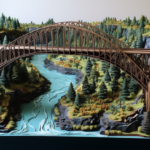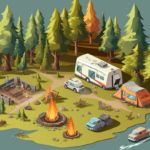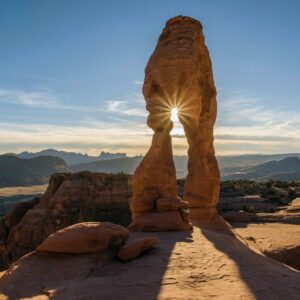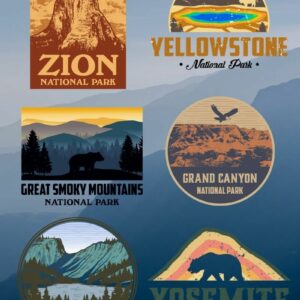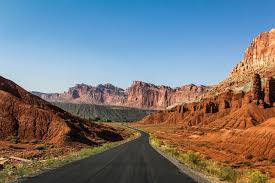Hawaii Volcanoes National Park
Hawaii Volcanoes National Park sees more than 1.1 million visitors each yearHawaii Volcanoes National Park, located on the Big Island of Hawaii, is a unique landscape that showcases some of the most active volcanoes on Earth. The park is home to Kīlauea and Mauna Loa, two of the world’s most active and massive shield volcanoes. Visitors can witness the raw power of nature as they explore volcanic craters, walk through lush rainforests, and experience the dynamic processes of creation and destruction in this extraordinary park.
Geology
Volcanoes are also prodigious land builders
Hawaii Volcanoes National Park is a testament to the power of Mother Nature and the dynamic processes that shape our planet. The park is home to two of the world’s most active volcanoes, Kilauea and Mauna Loa, which have been shaping the landscape of the Hawaiian Islands for hundreds of thousands of years. The geological history of the park is a fascinating tale of creation and destruction, as the relentless activity of the volcanoes continuously reshapes the terrain.
One of the most significant geological features of the park is the presence of invasive grasses, which have been increasing wildfire occurrence worldwide. In Hawaii, restoration sites are often planted with monocultures of the native tree Acacia koa, which can promote grass growth via nitrogen fixation. This, combined with the difficulty of estimating pre-fire grass cover under thick canopies, complicates attempts to restore Hawaiian ecosystems.
A study conducted on the 2018 Keauhou Ranch Fire in Hawaii investigated the impact of these grasses on the local ecosystem. The researchers found that in montane woodlands with low pre-fire tree densities, Acacia koa regeneration densities were higher with increased fire severity. However, this trend reversed when pre-fire tree densities were high. The study also found no effect of pre-fire grass cover, nor its interaction with fire severity, on Acacia koa regeneration density. This suggests that restoration through the planting of Acacia koa may be successful in promoting fire-resilient Acacia koa forest, although there are potential issues to consider regarding the effects that Acacia koa’s grass promotion may have on other species within the ecosystem.
The park’s geology is not just about the volcanoes and the vegetation. It’s also about the wildlife that calls the park home. The park is home to a variety of species, many of which have adapted to survive in the harsh volcanic landscape. However, the introduction of non-native species, such as the European mouflon sheep, has had a significant impact on the park’s ecosystem. These sheep have proliferated and degraded fragile native ecosystems in the Hawaiian Islands through browsing, bark stripping, and trampling, including native forests within Hawaii Volcanoes National Park.
The geology of Hawaii Volcanoes National Park is a complex interplay of volcanic activity, vegetation, and wildlife. The park’s landscape is continuously evolving, shaped by the forces of nature and human intervention. It serves as a living laboratory for scientists and a source of awe and inspiration for visitors from around the world.

Native American History
Superb voyagers, Polynesians from the Marquesas Islands migrated to Hawai`i over 1,600 years ago
The Native American history of Hawaii Volcanoes National Park is deeply intertwined with the natural landscape and the volcanic activity that has shaped it. The park is located on the Big Island of Hawaii, which is the ancestral home of the Native Hawaiian people. The volcanoes in the park, Kīlauea and Mauna Loa, are considered sacred in Hawaiian culture and are associated with Pele, the Hawaiian goddess of fire, lightning, wind, and volcanoes.
The Native Hawaiians have a deep spiritual connection to the land and the volcanoes. They believe that the volcanic eruptions are manifestations of Pele’s power. The park is home to many significant cultural sites, including ancient petroglyphs and heiau (temples), which provide a glimpse into the rich cultural history of the Native Hawaiians.
The Native Hawaiians have lived in harmony with the volcanoes for centuries, respecting their power and understanding their role in shaping the landscape and the ecosystem. They have developed a deep knowledge of the land and its resources, which they have passed down through generations. This knowledge includes an understanding of the volcanic processes, the flora and fauna of the park, and the importance of conservation.
The Native Hawaiians continue to maintain a strong cultural connection to Hawaii Volcanoes National Park. They continue to practice their traditional customs and rituals, including hula and chant, which honor Pele and express their respect for the land. The park is not just a place of natural beauty, but also a living cultural landscape that continues to be shaped by the Native Hawaiians’ spiritual beliefs and practices.
In recent years, there has been a growing recognition of the importance of incorporating Native Hawaiian knowledge and perspectives into the management and interpretation of the park. This has led to collaborations between the National Park Service and the Native Hawaiian community to protect and preserve the cultural and natural resources of the park. These collaborations are helping to ensure that the rich cultural heritage of the Native Hawaiians is respected and preserved for future generations.
For more detailed information, you can refer to these studies: [Understanding Grass Invasion, Fire Severity, and Acacia koa Regeneration for Forest Restoration in Hawaiʻi Volcanoes National Park](https://www.mdpi.com/2073-445X/10/9/962/pdf), [Talking with a Volcano: Native American Perspectives on the Eruption of Sunset Crater, Arizona](https://www.mdpi.com/2073-445X/11/2/196/pdf?version=1643271919), [Reframing Native Knowledge, Co-Managing Native Landscapes: Ethnographic Data and Tribal Engagement at Yosemite National Park](https://www.mdpi.com/2073-445X/9/9/335/pdf?version=1600754202), and [Monitoring Eradication of European Mouflon Sheep from the Kahuku Unit of Hawaiʻi Volcanoes National Park](https://bioone.org/journals/Pacific-Science/volume-71/issue-4/71.4.3/Monitoring-Eradication-of-European-Mouflon-Sheep-from-the-Kahuku-Unit/10.2984/71.4.3.pdf).

Park History
How Hawaii Volcanoes became a National Park
The story of how Hawaii Volcanoes National Park became a national park is a fascinating one. The park was established on August 1, 1916, by President Woodrow Wilson, making it the 15th national park in the United States. The idea for the park was first proposed by Lorrin A. Thurston, a local newspaper publisher and politician, who was inspired by the national parks he had seen on the mainland.
Thurston, along with Thomas Jaggar, a geologist who had founded the Hawaiian Volcano Observatory, began lobbying for the creation of a national park to preserve the unique volcanic landscape. They believed that the park would not only protect the area’s natural beauty but also promote scientific research and boost tourism.
Their efforts were successful, and in 1916, President Wilson signed the bill into law, creating Hawaii Volcanoes National Park. The park initially included only the summits of Kilauea and Mauna Loa, but over the years, it has expanded to include 333,000 acres from the summit of Mauna Loa to the sea.
Today, Hawaii Volcanoes National Park is a UNESCO World Heritage Site and continues to be a place of scientific research, cultural significance, and natural beauty. It attracts visitors from around the world who come to witness the power of nature and the ongoing process of creation and destruction.

Attractions
The best things to do in Hawaii Volcanoes National Park
If you’re planning a visit to the Hawaii Volcanoes National Park, there are plenty of activities to keep you entertained and in awe of nature’s power. Here are some of the best things to do in the park:
1. Explore the Volcanoes: The park is home to two of the world’s most active volcanoes, Kīlauea and Mauna Loa. You can hike around the craters, take a drive along the Crater Rim Drive, and witness the awe-inspiring sight of glowing lava at night.
2. Hiking: There are over 150 miles of hiking trails in the park that take you through rainforests, deserts, and volcanic craters. Some popular trails include the Kīlauea Iki Trail, the Halema’uma’u Trail, and the Mauna Loa Summit Trail.
3. Ranger-led Programs: The park offers a variety of ranger-led programs that are both educational and fun. These include guided hikes, talks, and demonstrations that provide insight into the park’s geology, history, and ecology.
4. Wildlife Viewing: The park is home to a variety of native Hawaiian species. Keep an eye out for the nēnē (Hawaiian goose), the state bird of Hawaii, as well as other endemic species like the Hawaiian hoary bat and the happy-face spider.
5. Visit the Jaggar Museum: Although the museum is currently closed due to the recent volcanic activity, it’s worth a visit when it reopens. The museum offers exhibits on volcanology, seismology, and the cultural significance of volcanoes in Hawaii.
6. Stargazing: The clear skies over the park make it an excellent place for stargazing. Join a ranger-led stargazing program or simply lay back and enjoy the view.
7. Photography: With its dramatic landscapes and unique flora and fauna, the park is a photographer’s dream. Don’t forget to bring your camera!
Remember, the park is a dynamic and changing environment due to its active volcanoes. Always check the park’s website for the latest information on trail and road closures, volcanic activity, and safety tips. Enjoy your visit to this incredible testament to the power of nature!

Vegetation
Evolving over 70 million years ago in nearly complete isolation, more than 90% of the state’s native flora are found only in the Hawaiian Islands
The lush vegetation of Hawaii Volcanoes National Park is a testament to the resilience of nature, thriving amidst the harsh volcanic landscapes. The park is home to a diverse array of plant species, each uniquely adapted to the challenging conditions. The vegetation cover plays a crucial role in the balanced functioning of the park’s ecosystems, contributing to the overall biodiversity and attracting the attention of scientists worldwide.
The flora of the park is influenced by various abiotic factors such as light, temperature, humidity, and soil. These factors significantly impact the formation of vegetation cover and the life processes of plants. The park is predominantly populated by mesophytes, plants that thrive in medium humidity conditions. These include most trees and shrubs, meadow and forest grasses. There are also hygrophytes, plants that live in conditions of excessive moisture, and a small group of hydrophytes, higher aquatic plants attached to the soil and submerged in water only with their lower part.
The vegetation cover of Hawaii Volcanoes National Park is not only diverse but also plays an essential role in the ecosystem. It contributes to the absorption of various substances and energy from other components of ecosystems and their synthesis into primary organic substances used for building the bodies of plants and for their internal catabolism. The vegetation cover also contributes to the release of waste products by vegetation, and with them part of the captured energy during their formation. It also plays a role in the return to the atmosphere and soil of a part of the accumulated energy and substance during the death of organs or whole plants.
The park’s vegetation also plays a crucial role in the transformation of the properties and states of other components of ecosystems in the process of growth, absorption, accumulation, and release of substances and energy. The vegetation cover also has a significant environmental stabilization value, soil-protecting, water-saving, landscape, aesthetic, scientific, and educational. It provides protection for rare populations, with many rare and endangered plant species being consortium associated with rare representatives of the animal world.
The flora of Hawaii Volcanoes National Park is a testament to the power of nature to adapt and thrive in the most challenging conditions. It is a living laboratory for scientists and a source of wonder and beauty for visitors. It is a testament to the resilience of life and a reminder of the importance of preserving and protecting our natural world.
Read More: https://www.e3s-conferences.org/articles/e3sconf/pdf/2021/56/e3sconf_icsf2021_11008.pdf

Animal Life
From bats to snails, you’ll find a diverse animal life in Hawai’i Volcanoes National Park
Hawaii Volcanoes National Park is a sanctuary for a diverse range of animal species, many of which are unique to the Hawaiian Islands. The park is home to a variety of birds, insects, and mammals.
One of the most iconic animals of the park is the Hawaiian goose, or nēnē, which is the state bird of Hawaii and can be found in various parts of the park. The park also hosts a variety of native bird species such as the ‘apapane, ‘amakihi, and the endangered ‘akepa and ‘akiapōlā’au.
In terms of mammals, the park is home to the Hawaiian hoary bat, the only land mammal native to Hawaii. Other mammals in the park are introduced species, such as rats, mongoose, and feral pigs, which can have significant impacts on native ecosystems.
The park is also home to a variety of insects and spiders, many of which are endemic to the Hawaiian Islands. These include the happy face spider, known for the unique patterns on its abdomen, and the carnivorous caterpillars of the genus Eupithecia.
The park’s marine areas also host a variety of life, including green sea turtles and the endangered hawksbill sea turtles, which can often be seen on the park’s coastal areas.
A different study conducted in Volcanoes National Park highlighted the significant impact of former poachers on wildlife conservation. The research indicated that the main causes of poaching and other illegal activities are associated with poverty, ignorance, culture, and commercial purposes.
Interestingly, the study found that poaching cases decreased in the park from 2018, with the number of snares removed from the park reducing from above 1000 to 600 snares. In the same year, only 3 poachers from Kinigi and Shingiro Sectors were arrested. This reduction in poaching activities was attributed to the introduction of a revenue-sharing scheme, where 10% of the park’s revenues are shared with the local communities living adjacent to the park.
The construction of a buffalo wall stone around the Volcanoes National Park also contributed to the decrease in poaching activities. However, some respondents reported that the construction of the buffalo wall did not prevent animals from escaping the park, leading to proposals for the construction of a stronger fence, such as an electrically fenced wall.
The study concluded that the contribution of former poachers is highly significant in both tourism and environmental sectors, especially after giving up such illegal activities. They have become wildlife conservation preachers due to a number of benefits they earn such as employment opportunities, improvement of living conditions, and infrastructure development through the effective implementation of the revenue-sharing scheme.
The wildlife of Hawaii Volcanoes National Park is a testament to the resilience of nature, even in the face of human-induced challenges. The efforts to protect and conserve this diverse fauna are a beacon of hope for other wildlife conservation efforts worldwide.
It’s important to remember that many of these species are sensitive and may be threatened or endangered. Visitors to the park are encouraged to observe wildlife from a distance and to avoid disturbing animals or their habitats.

Hiking Trails
The best hiking trails in Hawaii Volcanoes National Park
Here are some of the best hiking trails in Hawaii Volcanoes National Park:
1. Kīlauea Iki Trail: This trail is a 4-mile loop that takes you through a lush rainforest and into a solidified volcanic crater. The trail offers stunning views of the Kīlauea Iki Crater and the main caldera of Kīlauea Volcano.
2. Crater Rim Trail: This 11-mile trail circles the summit caldera of Kīlauea volcano. It offers diverse scenery, including tropical rainforests, deserts, and volcanic craters. Parts of the trail are closed due to volcanic activity, but the open sections still offer a great hiking experience.
3. Nāpau Trail: This trail takes you through the East Rift Zone of the Kīlauea Volcano. It’s a longer hike, about 14 miles round trip, but it offers the chance to see several volcanic craters and the most recent lava flows.
4. Mauna Iki Trail: This trail is a 3-mile round trip hike that takes you to the site of the 1919 Mauna Iki eruption. You’ll see several lava trees and other interesting volcanic features along the way.
5. Devastation Trail: This paved trail is an easy 1-mile round trip hike that shows the impact of the 1959 Kīlauea Iki eruption. You’ll see a stark landscape of cinder outfall and the regrowth of the surrounding forest.
Remember, hiking in a volcanic landscape can be challenging and potentially dangerous. Always check the current conditions before you start your hike, stay on marked trails, and bring plenty of water and sun protection.
For more detailed information about these trails and others in the park, I recommend checking out the [Hawaii Volcanoes National Park website](https://www.nps.gov/havo/planyourvisit/hike.htm).







